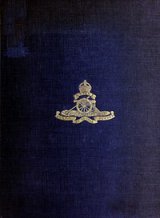The History of the 33rd Divisional Artillery, in the War, 1914-1918
"Yet the record of their actions is their best memorial." Field-Marshal
Earl Haig wrote the above words in his foreword to the Royal Artillery
War Commemoration Book. When it is recalled that during the Great War
some three-quarters of a million of men fought guns of all calibres in
every quarter of the globe, it may be realised that to write the history
of the part taken by the Royal Regiment of Artillery as a whole must
prove an impossible task.
All the more important therefore that each unit should take steps to
place on record its own doings.
The 33rd Divisional Artillery fought in many important battles and
engagements, and always fought with distinction and with the devotion
worthy of the tradition of the Royal Regiment. This record bears witness
of the high stage of efficiency attained by the Brigades and Batteries
of the New Army, and we may say with our great Commander-in-Chief "The
record of their actions is their best memorial."
- Year:
- 2016
- 1,109 Views
INTRODUCTION. To write the history of a unit in the war must, even to the most able pen, prove a mighty task, for it is not given to many to be able in words to describe deeds greater almost than human intellect can grasp. But when the task falls to the lot of one who, himself neither author nor historian, can claim as a sole reason the fact that it was his humble privilege to serve with the unit in question, the work becomes doubly and trebly difficult. In a book of this nature it is probably desirable that personal experience should have preference to powers of rhetoric, and a knowledge of facts to fluency with the pen, and for this reason, after much hesitation, the work was undertaken. No skilful framing of words can portray in any way adequately a war history; far better is it that in simple language should be recounted the story of the batteries, so that each man may judge of it according to his lights. This History has been written primarily as a permanent record for all those who served with the 33rd Divisional Artillery, a record which they may keep for the benefit of themselves and their descendants when, in years to come, the intervening space becomes blurred by the mist of forgetfulness, and the story of those mighty days in France lies in danger of being relegated to the shadowy past. Secondly, it has been published in order that all those who were in any way connected with the gunners of this Division may learn something of their doings in France, may gain a little insight into the daily lives of those whose deeds they can but dimly comprehend. Moreover, although many regimental histories have already been published, this is one of the first to devote itself to the doings of a Divisional Artillery, and, throwing much light as it does upon the daily life of a field gunner in France, it must be of considerable interest to all those who wish to know something of the work of an artillery unit in the war. Lastly, since it deals in detail with every battle in which the 33rd Divisional Artillery was concerned, it will be found to contain records of minor incidents and operations into which the wider histories of the war cannot enter, but which were of vital importance to the actual troops concerned. The expense of publishing the History has been borne entirely by old members of the 33rd Divisional Artillery, and in this respect I must express my deep gratitude to Captain Leonard Vestey, Major D. M. Coffin and Colonel Sir Frederick Hall, by whose generosity, combined with that of several others, the publication of this book has been rendered possible. For personal help in collecting information and facts, checking dates and generally verifying the accuracy of the work I am also indebted to Brigadier-General C. G. Stewart, Lieut.-Col. O. M. Harris, Lieut.-Col. E. J. Skinner, Major M. A. Studd, Major D. M. Coffin, Major R. D. Russell and Major S. G. Taylor. Finally, I wish to acknowledge the courtesy of the War Office in permitting the reproduction in this volume of the official maps used in France during the war. JOHN MACARTNEY-FILGATE. LONDON, May, 1921. CHAPTER I. EARLY DAYS August 1914 and its succeeding months will ever recall to the minds of that generation which was privileged to live through those epic days memories of a great turmoil, a chaos, a shattering of that normal—and in many cases humdrum—existence which to the majority represented Life. The outstanding impression will depend upon the character of the person who looks back—to some it will be a sense of overwhelming surprise, to some a rending and shattering of all their dreams of a long-awaited happy future, while to some it will be the promise of Great Adventure, the chance of seeing Life face to face and stripped of all its petty adornments and falsities, a sight vouchsafed to few and one which of necessity brings with it the presence of that companion Death, so closely allied to Life in its fierce and primitive state. Yet whatever the recollection and whatever may be the impressions retained, to one and all remains that proud memory of the wild enthusiasm which greeted the call to arms, the readiness to fight, to leave comfortable homes, to give up everything because the Country called for men; because the Country, whatever the cause of the war might be, was in peril. The 33rd Divisional Artillery, as its number implies, was not one of the first to be formed. So great was the early rush to the recruiting stations that the machinery to deal with the enlistment of men was unable to cope with it, and it was not until January 14th, 1915, that a War Office letter addressed to the Mayor of Camberwell authorised the recruiting of the 156th Brigade, Royal Field Artillery, by Major Frederick Hall M.P. in the Borough of Camberwell. So prompt was the response to this call that in March further authority was granted for the recruitment of the 162nd Brigade R.F.A. in the same neighbourhood, the formation of this Brigade being completed by the middle of May, when it was placed under the command of Major Duncan. It was then brought to the attention of the authorities that there still remained masses of excellent material in Camberwell, that the district was overflowing with would-be recruits not yet enlisted, and that the whole of the 33rd Divisional Artillery might well be raised from there—a scheme which was received by the Borough with the greatest enthusiasm. The required authority was obtained; the 166th and 167th Brigades R.F.A., the 126th Battery of Heavy Artillery and the attendant Ammunition Column were formed, and on June 1st 1915 the 33rd Divisional Artillery, as such, was complete, manned to its full strength, and manned by the men of Camberwell and Dulwich. Meantime, from the day on which the first recruits had arrived, training was carried on with the utmost vigour. N.C.O. instructors were scarce, very few officers had been posted to the Division, and any kind of uniform was noticeable by its absence. The early training of recruits in those days was not calculated to enhance in their minds the glamour of war; clad in the roughest and, in many cases, most tattered of civilian clothes, shod in the boots which they had brought with them, they were taught—day in, day out—that there were many accomplishments which they must learn before they would be fit for service in the field; that personal gallantry, a feeling of complete superiority over the enemy, and a fixed intention of "sticking it with the best" would not alone take them to France. They must learn to indulge in that strange form of recreation known as "knees bending with arms raising," and all its accompanying acrobatics; they must be initiated into the mysteries of knotting and lashing, of horse management, of dismounted drill and a hundred and one other matters which go to form the training of a soldier. And then, when their knees ached with bending and stretching, when their brains whirled in trying to fashion some especially important and therefore, to their minds, difficult knot, when some of the most tender portions of their anatomy felt as though one more minute in the saddle would cut right through to the bone, Gunnery descended upon them. Gunnery, with its drill and its intricate and complicated mechanism, opened out a completely new item of training, a hitherto untrodden part of the long and tedious road which led from Camberwell and Dulwich to the battlefields of France. Yet to the weary mind of the recruit there was one great consolation. Here at last was something tangible; here was something which spoke of War, which brought him much nearer to the goal of his endeavours. "Physical jerks" and the lurid remarks of riding masters were all very well in their way, but the average recruit had no intention of lying on his back outside a trench in France and of solemnly raising his feet in the air to let them have a look, as it were, at fresh surroundings; he had no desire to trot along a road behind the Line without stirrups or reins, although he was quite prepared to recognise that it was a useful feat to be able to perform. No, he wanted to fling shells at the enemy, to be able to inflict upon the "other side" all that extreme discomfort which artillery is capable of administering; he wanted, in short, a gun, and at last he saw one before him.
Translation
Translate and read this book in other languages:
Select another language:
- - Select -
- 简体中文 (Chinese - Simplified)
- 繁體中文 (Chinese - Traditional)
- Español (Spanish)
- Esperanto (Esperanto)
- 日本語 (Japanese)
- Português (Portuguese)
- Deutsch (German)
- العربية (Arabic)
- Français (French)
- Русский (Russian)
- ಕನ್ನಡ (Kannada)
- 한국어 (Korean)
- עברית (Hebrew)
- Gaeilge (Irish)
- Українська (Ukrainian)
- اردو (Urdu)
- Magyar (Hungarian)
- मानक हिन्दी (Hindi)
- Indonesia (Indonesian)
- Italiano (Italian)
- தமிழ் (Tamil)
- Türkçe (Turkish)
- తెలుగు (Telugu)
- ภาษาไทย (Thai)
- Tiếng Việt (Vietnamese)
- Čeština (Czech)
- Polski (Polish)
- Bahasa Indonesia (Indonesian)
- Românește (Romanian)
- Nederlands (Dutch)
- Ελληνικά (Greek)
- Latinum (Latin)
- Svenska (Swedish)
- Dansk (Danish)
- Suomi (Finnish)
- فارسی (Persian)
- ייִדיש (Yiddish)
- հայերեն (Armenian)
- Norsk (Norwegian)
- English (English)
Citation
Use the citation below to add this book to your bibliography:
Style:MLAChicagoAPA
"The History of the 33rd Divisional Artillery, in the War, 1914-1918 Books." Literature.com. STANDS4 LLC, 2024. Web. 19 Apr. 2024. <https://www.literature.com/book/the_history_of_the_33rd_divisional_artillery%2C_in_the_war%2C_1914-1918_4>.




Discuss this The History of the 33rd Divisional Artillery, in the War, 1914-1918 book with the community:
Report Comment
We're doing our best to make sure our content is useful, accurate and safe.
If by any chance you spot an inappropriate comment while navigating through our website please use this form to let us know, and we'll take care of it shortly.
Attachment
You need to be logged in to favorite.
Log In